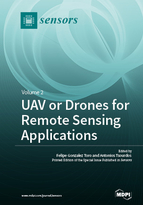UAV or Drones for Remote Sensing Applications
A special issue of Sensors (ISSN 1424-8220). This special issue belongs to the section "Remote Sensors".
Deadline for manuscript submissions: closed (15 December 2017) | Viewed by 302285
Special Issue Editors
Interests: remote sensing; UAV; unmanned aerial systems (UAS); bioinspired optimisation; multidisciplinary design optimisation; optimisation; drones; wildlife monitoring; precision agriculture
Special Issues, Collections and Topics in MDPI journals
Interests: unmanned aircraft systems; decision making on multi-agent systems; data-centric guidance and control; swarm
Special Issues, Collections and Topics in MDPI journals
Special Issue Information
Dear Colleagues,
The rapid development and growth of UAVs as a remote sensing platform, as well as advances in the miniaturization of instrumentation and data systems, have resulted in an increasing uptake of this technology in the environmental and remote sensing science community.
Even though, tough regulations across the globe may still limit the broader use of UAVs, their use is precision agriculture, ecology, atmospheric research, disaster response bio-security, ecological and reef monitoring, forestry, fire monitoring, quick response measurements for emergency disaster, Earth science research, volcanic gas sampling, monitoring of gas pipelines, mining plumes, humanitarian observations and biological/chemosensing tasks, continues to increase.
The Special Issue provides a forum for high-quality peer-reviewed papers that broaden awareness and understanding of UAV developments, applications of UAVs for Remote Sensing, and associated developments in sensor technology, data processing and communications, and UAV system design and sensing capabilities.
Prospective authors are invited to contribute to this Special Issue of Sensors (Impact Factor: 2.677 (2016); 5-Year Impact Factor: 2.964 (2016)) by submitting an original manuscript.
The scope of this Special Issue includes, but it is not limited to:
Applications of UAV in GPS denied environments
improvements in UAV sensor technology
microUAV applications
UAV sensor design,
descriptions of processing algorithms applied to UAV-based imagery datasets
the use of Optical, multi-spectral, hyperspectral, laser, and optical SAR technologies onboard UAVs
Gas analyzers and sensors
Artificial intelligence and data mining based strategies from UAV-acquired datasets
UAV onboard data storage, transmission, and retrieval
Collaborative strategies and mechanisms to control multiple UAVs and sensor networks
Multiple platform UAV, AUV, ground robot networks
UAV sensor applications including: Precision agriculture; construction, mining, pest detection, forestry, mammal species tracking search and rescue; target tracking, the monitoring of the atmosphere; chemical, biological, and natural disaster phenomena; fire prevention, flood prevention; reef, volcanic monitoring, Earth science research pollution monitoring, micro-climates , land use precision agriculture, ecology, atmospheric research, bio-security, forestry, fire monitoring, quick response measurements for emergency disaster, pollution monitoring, volcanic gas sampling, monitoring of gas pipelines, biological/chemosensing tasks, and humanitarian observations.
Assoc. Prof. Dr. Felipe Gonzalez Toro
Prof. Dr. Antonios Tsourdos
Guest Editors
Manuscript Submission Information
Manuscripts should be submitted online at www.mdpi.com by registering and logging in to this website. Once you are registered, click here to go to the submission form. Manuscripts can be submitted until the deadline. All submissions that pass pre-check are peer-reviewed. Accepted papers will be published continuously in the journal (as soon as accepted) and will be listed together on the special issue website. Research articles, review articles as well as short communications are invited. For planned papers, a title and short abstract (about 100 words) can be sent to the Editorial Office for announcement on this website.
Submitted manuscripts should not have been published previously, nor be under consideration for publication elsewhere (except conference proceedings papers). All manuscripts are thoroughly refereed through a single-blind peer-review process. A guide for authors and other relevant information for submission of manuscripts is available on the Instructions for Authors page. Sensors is an international peer-reviewed open access semimonthly journal published by MDPI.
Please visit the Instructions for Authors page before submitting a manuscript. The Article Processing Charge (APC) for publication in this open access journal is 2600 CHF (Swiss Francs). Submitted papers should be well formatted and use good English. Authors may use MDPI's English editing service prior to publication or during author revisions.








